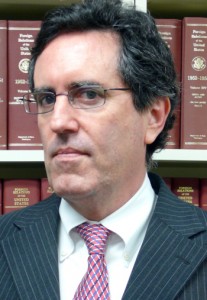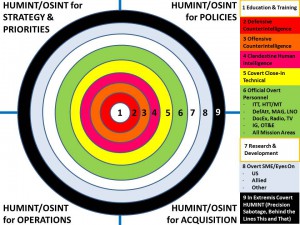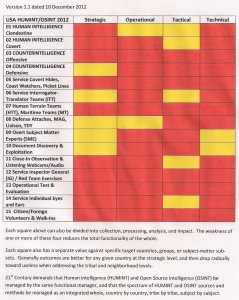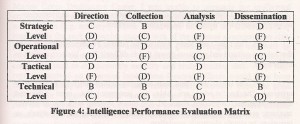
Updated 11 Dec 2012 to add Graphic: Intelligence Requirements, Collection, Evaluation, and Capabilities Building
Senate Puts Brakes on Defense Clandestine Service
The Senate moved last week to restrain the rapid growth of the Defense Clandestine Service, the Pentagon’s human intelligence operation.
Under a provision of the FY2013 defense authorization act that was approved on December 4, the Pentagon would be prohibited from hiring any more spies than it had as of last April, and it would have to provide detailed cost estimates and program plans in forthcoming reports to Congress.
“DoD needs to demonstrate that it can improve the management of clandestine HUMINT before undertaking any further expansion,” the Senate Armed Services Committee wrote in a report on the new legislation.
Longstanding problems with defense human intelligence cited by the Committee include: “inefficient utilization of personnel trained at significant expense to conduct clandestine HUMINT; poor or non-existent career management for trained HUMINT personnel; cover challenges; and unproductive deployment locations.”
The Committee noted further that “President Bush authorized 50 percent growth in the CIA’s case officer workforce, which followed significant growth under President Clinton. Since 9/11, DOD’s case officer ranks have grown substantially as well. The committee is concerned that, despite this expansion and the winding down of two overseas conflicts that required large HUMINT resources, DOD believes that its needs are not being met.”
Instead of an ambitious expansion, a tailored reduction in defense intelligence spending might be more appropriate, the Committee said.
“If DOD is able to utilize existing resources much more effectively, the case could be made that investment in this area could decline, rather than remain steady or grow, to assist the Department in managing its fiscal and personnel challenges,” the Senate Committee wrote.
The Washington Post published a revealing account of Pentagon plans to expand the size and reach of the defense human intelligence program in “DIA sending hundreds more spies overseas” by Greg Miller, December 1.
Along with overhead surveillance, bolstering human intelligence has been the focus of one of two major defense intelligence initiatives, said Under Secretary of Defense (Intelligence) Michael G. Vickers last October. The Defense Clandestine Service “enable[s] us to be more effective in the collection of national-level clandestine human intelligence across a range of targets of paramount interest to the Department of Defense,” he said.
The latest issues of the U.S. Army’s Military Intelligence Professional Bulletin, released under the Freedom of Information Act, are available here (in some very large pdf files).
“A Short History of Army Intelligence” by Michael E. Bigelow of US Army Intelligence and Security Command, dated July 2012, is available here.
Newly updated doctrine from the Joint Chiefs of Staff includes Information Operations, JP 3-13, 27 November 2012, and Joint Forcible Entry Operations, JP 3-18, 27 November 2012.







